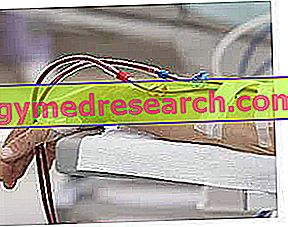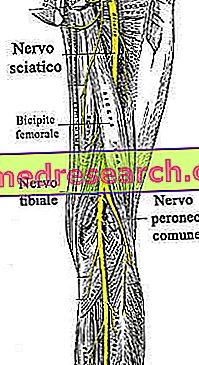What is dialysis
Dialysis is a treatment that artificially reproduces certain functions of the kidney, cleaning up the blood from excess waste products and water.

Dialysis respects the principles of passive solute diffusion and ultrafiltration of fluids, allowing the reproduction of renal filtration to be reproduced. The patient's blood flows through a dialysis membrane with pores of various sizes, wide enough to allow the passage of small ions and solutes between two compartments of liquids, but not enough to allow even larger components to escape, such as red blood cells and plasma proteins . On the other side of the membrane flows a particular dialysis liquid, whose composition ensures that the most important solutes remain in circulation.
Although dialysis is not a cure, it can prolong the life span of the patient, waiting for a donor to be available for a kidney transplant.
Renal filtration and dialysis
Every day the kidneys filter the blood, eliminating waste products and excess water and ions that together make up urine. When healthy, the kidneys regulate the concentration of ions (Na +, K +, H +, HCO3-), of other solutes (such as glucose, amino acids, etc.) and of water in the blood, and remove the products of waste metabolism. However, if the nephrons, the functional units of the kidney, are damaged, the normal processes that take place inside them (filtration, secretion, reabsorption and excretion) can be compromised. As a result, the amount of waste products in the blood accumulates to dangerous levels and - in the absence of treatment - can prove fatal.
Dialysis is a treatment that compensates for the poor efficiency of some kidney functions affected by the disease:
- Removal of toxic substances (urea, uric acid, creatinine and other molecules);
- Electrolytic and acid-base rebalancing, keeping some substances, such as potassium, sodium and bicarbonate, at a safe level in the blood;
- Removal of liquids (taken through food and not eliminated with diuresis).
When needed
The loss of renal function can be the common consequence of a great variety of pathologies, which affect the kidneys directly (eg: glomerulonephritis, polycystic kidney disease, chronic kidney disease, repeated kidney infections, etc.) or indirectly (such as diabetes or hypertension ).
If the kidneys stop functioning properly, the waste products accumulate in the blood and cause manifestations such as:
- He retched;
- Itching of the skin;
- Fatigue (extreme fatigue);
- Blood in the urine (hematuria),
- Swelling of feet, hands and ankles.
Symptoms tend to appear when the disease is in an advanced stage, as the kidney has a large functional reserve. Dialysis is recommended for the appearance of clinical signs representative of a severe loss of renal function, with dangerously high levels of waste products in the blood ( uremia ).
In some cases, dialysis may be recommended regardless of whether the patient has started experiencing uremia symptoms. A glomerular filtration rate of less than 15 ml / min (VFG, measures how many milliliters of blood the kidneys are able to filter at a given time) is a valid indication to begin dialysis treatment.
Acute renal failure. A common reason why dialysis may be needed is a serious kidney infection that leads to a sudden loss of their function (known as acute kidney failure). In this case, the dialysis treatment is necessary only temporarily, until the recovery of the physiological activity of the kidneys.
Types of dialysis
The two main types of dialysis, hemodialysis and peritoneal dialysis, remove waste substances and excess liquids from the blood in different ways.
- Hemodialysis
Hemodialysis involves the passage of the patient's blood through a system called the artificial kidney. The dialysis device contains a semipermeable membrane that divides the internal space into several compartments: one contains the liquid for dialysis, the other the blood sent to the machine by an arterial catheter. As the blood proceeds inside the apparatus, exchanges of solutes occur between the blood and the dialysis fluid through the membrane. This membrane, being semipermeable, allows the passage of the molecules according to their electrochemical gradient (passive diffusion), preventing that of the corpusculated elements of the blood and proteins. The levels of the components of the dialysis fluid can vary and are typically prescribed by a nephrologist according to the needs of the individual patient, in order to favor the movement of particular molecules in a particular direction. After exchange, the blood leaves the device and returns to the patient through to a venous catheter. Most patients require three sessions a week, each lasting four hours.
- Peritoneal dialysis
Peritoneal dialysis exploits a membrane present inside the body, the peritoneum, in the same way as the semipermeable membrane in hemodialysis is used. The peritoneum is a thin membrane that covers the inside of the abdomen and surrounds and supports the abdominal organs, such as the stomach and the liver. Like the kidneys, the peritoneum contains thousands of small blood vessels, which makes it useful as a filtering device. During this type of dialysis, the dialysis fluid is introduced thanks to a catheter inside the peritoneal cavity. In this way, an exchange of solutes occurs between the blood that runs through the peritoneum capillaries and the dialysis liquid contained in the peritoneal cavity. After a certain period of time (about 4-6 hours), the dialysate fluid is removed from the abdominal cavity.
Advantages and disadvantages
In many cases, the choice of the type of dialysis to be taken depends on the patient, since both hemodialysis and peritoneal dialysis allow to obtain similar results. However, some health problems can make one method more advisable than another (for example, if the patient has undergone a previous operation on the abdomen).
In general, peritoneal dialysis is usually recommended as a first form of treatment for:
- Children from two years of age;
- Adults with kidney disease but who do not have other serious health conditions, such as heart disease or cancer.
Hemodialysis is usually recommended for people who cannot undergo peritoneal dialysis, such as older patients, who are not in good overall health. The decision on which treatment method to undertake is not final and it is possible to switch from one type of dialysis to another.
Dialysis can cause some side effects :
- Fatigue. An undesirable manifestation common to both hemodialysis and peritoneal dialysis consists in a persistent feeling of tiredness, caused by a combination of effects that the therapy can have on the organism.
- Anemia. It represents a common complication of chronic renal failure, due to the reduced secretion of erythropoietin, a hormone that stimulates the formation of red blood cells. Dietary restrictions or loss of iron and vitamins through hemodialysis may contribute to anemia.
- Bone weakening. If the damaged kidneys are no longer able to process vitamin D, calcium metabolism disorders can occur.
- Itch. Many people who undergo hemodialysis experience itchy skin, which is often worse during or immediately after the procedure. This effect is believed to be due to an accumulation of potassium in the body. Avoiding potassium-rich foods can help reduce the frequency and severity of this symptom.
- Low blood pressure (hypotension). A drop in blood pressure is one of the most common side effects of hemodialysis, particularly if the patient is diabetic. Hypotension can be caused by the drop in fluid levels that occurs during dialysis. The best way to minimize symptoms of low blood pressure (shortness of breath, abdominal and muscle cramps, nausea or vomiting) is to keep the daily fluid intake at the levels suggested by the doctor. If hypotensive symptoms persist, probably the amount of fluid used during dialysis requires adjustment.
- Muscle cramps. During a hemodialysis session, some people experience muscle cramps, usually in the lower part of the legs. This effect is probably due to the reaction of the muscles to the loss of fluids that occurs during hemodialysis. Sometimes, cramps can be alleviated by adjusting fluids and sodium intake between hemodialysis treatments.
- Liquid overload. Since the fluid is removed from the body during hemodialysis, drinking more fluids than recommended between hemodialysis treatments can cause life-threatening complications, such as heart failure or fluid build-up in the lungs (pulmonary edema).
- High blood pressure (hypertension). If you consume too much salt or drink too much liquid, high blood pressure is bound to worsen and lead to cardiac complications.
- High potassium levels (hyperkalemia). Potassium is a mineral that is normally removed from the body through the kidneys. If you take more potassium than is recommended, the level can become too high and, in severe cases, can cause heart problems.
- Amyloidosis. Dialysis-related amyloidosis develops when blood protein is deposited on tendons and joints, causing pain, stiffness and joint effusion. The condition is more common in patients who have undergone hemodialysis for a long time (indicatively more than five years).
- Staphylococcal infections. Hemodialysis patients have an increased risk of developing a Staphylococcus aureus infection. The hemodialysis process can allow bacteria to enter the body where they can cause a severe invasive infection. This can spread through the blood, leading to multiple organ dysfunction (sepsis). Sepsis associated with an invasive staph infection is the second most common cause of death, after heart disease, in patients undergoing hemodialysis.
- Peritonitis. A common side effect of peritoneal dialysis is bacterial infection of the peritoneum. Peritonitis can occur if the dialysis equipment is not kept properly sterilized. Patients on hemodialysis have a lower risk of contracting the infection, but if this occurs, it tends to be more severe.
- Weight gain. The dialysis fluid that is used during peritoneal dialysis contains sugar molecules, some of which can be absorbed by the body. This effect can lead to an increase in weight, if the daily caloric intake is not reduced with an adequate dietary regime possibly supported - under medical advice - by regular exercise.
Results
Dialysis is a challenging treatment, which requires considerable patient collaboration, but also represents a potential life-saving measure. The success of dialysis in the treatment of kidney failure depends on a number of factors, including the age of the patient and any chronic concomitant diseases (such as heart disease or diabetes). Also the etiology of the pathology influences the survival rates; for example, people with kidney failure caused by polycystic kidney disease and glomerulonephritis tend to have a better long-term prognosis than patients who experience the condition as a complication of high blood pressure or diabetes. Unfortunately, dialysis can compensate for the loss of renal function only to a certain extent and is not a definitive cure. Many people remain on dialysis for a long period of time (in some cases, for the rest of their lives), but for a significant minority of patients the ultimate goal is kidney transplantation, which is the best treatment for the kidney failure. A suitable candidate for such an intervention must undergo dialysis until a compatible donor (dead or living) is available. This period of time can vary from a couple of months to about three years. Patients who are not suitable for a kidney transplant, due to another serious concomitant health condition, such as a tumor or severe heart disease, will need to be on dialysis for the rest of their lives. Often, this is a safer option than a transplant.



